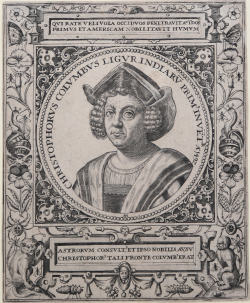



| Reference: | S31252 |
| Author | Theodor DE BRY |
| Year: | 1590 ca. |
| Zone: | Christopher Columbus |
| Printed: | Frankfurt |
| Measures: | 127 x 156 mm |



| Reference: | S31252 |
| Author | Theodor DE BRY |
| Year: | 1590 ca. |
| Zone: | Christopher Columbus |
| Printed: | Frankfurt |
| Measures: | 127 x 156 mm |
Portrait of the Genoane explorer engraved with graver. The portrait has been included in Bry’s Piccoli Viaggi. Copperplate, rich in decoration, trimmed to platemark, in excellent condition.
Collection stamp on verso, unidentified.
|
Nagler, Die Monogrammisten I, 1880.
|
Theodor DE BRY (Liegi, 1528 - Frankfurt am Main, 29 Marzo 1598).
|
Engraver, printmaker, publisher and goldsmith. He was apparently trained in Liège as a goldsmith and engraver and was active (under the name Dietrich Brey) as a goldsmith in Strasbourg, where in 1560 he married Catherine Esslinger (1570). He returned to Liège in 1561, where his eldest son, Johann Theodor de Bry, was born, but because of his Lutheran religious convictions de Bry left Liège again to establish citizenship in Strasbourg, where he lived from 1570 to c. 1586 and where his second son, Johann Israel de Bry (b Liège, before 1570; d Frankfurt, 1611), was born. While there he came under the stylistic influence of the Parisian Huguenot Etienne Delaune, who had fled to Strasbourg in 1572. De Bry was married a second time, in 1570, to Catherine, daughter of the Frankfurt goldsmith Hans Rotlinger. In 1588 the de Bry household moved permanently to Frankfurt while Theodor was in England (c. 1586–9) making engraved copies after the watercolours of JOHN WHITE of scenes from the New World. These, with his copies after similar works by Jacques Le Moyne de Morgues, are his best-known engravings and were used as illustrations in the ten volumes of American travel literature (Grands voyages, Frankfurt am Main, 1590–1618) that he and his sons published. These were a compilation of Girolamo Benzoni’s History of the New World, Thomas Hariot’s Briefe and True Report of the New Found Land of Virginia and a memoir by Hans Staden of his adventures among the cannibals of Brazil. De Bry’s Lutheran bias led him to emphasize the cruelty of the Spanish conquerors toward the natives they encountered in Peru, and his landscape and figure formulae were made to conform to European standards (the influences of Joachim Patinir and Herri met de Bles are particularly striking). These engravings were the medium through which most Europeans came to view the costumes and customs of the American Indians. He also published a series of portraits of famous men—including Gerard Mercator (1512–94) and Copernicus (1473–1543)—engraved after drawings by Jean-Jacques Boissard (Icones quinquaginta vivorum illustrium doctrine et eruditione praestantium ad vivum effectae, Frankfurt am Main, (1597–9). The engravings, by a number of different artists, form an important precedent for van Dyck’s Iconographie of 1632–44.
|
|
Nagler, Die Monogrammisten I, 1880.
|
Theodor DE BRY (Liegi, 1528 - Frankfurt am Main, 29 Marzo 1598).
|
Engraver, printmaker, publisher and goldsmith. He was apparently trained in Liège as a goldsmith and engraver and was active (under the name Dietrich Brey) as a goldsmith in Strasbourg, where in 1560 he married Catherine Esslinger (1570). He returned to Liège in 1561, where his eldest son, Johann Theodor de Bry, was born, but because of his Lutheran religious convictions de Bry left Liège again to establish citizenship in Strasbourg, where he lived from 1570 to c. 1586 and where his second son, Johann Israel de Bry (b Liège, before 1570; d Frankfurt, 1611), was born. While there he came under the stylistic influence of the Parisian Huguenot Etienne Delaune, who had fled to Strasbourg in 1572. De Bry was married a second time, in 1570, to Catherine, daughter of the Frankfurt goldsmith Hans Rotlinger. In 1588 the de Bry household moved permanently to Frankfurt while Theodor was in England (c. 1586–9) making engraved copies after the watercolours of JOHN WHITE of scenes from the New World. These, with his copies after similar works by Jacques Le Moyne de Morgues, are his best-known engravings and were used as illustrations in the ten volumes of American travel literature (Grands voyages, Frankfurt am Main, 1590–1618) that he and his sons published. These were a compilation of Girolamo Benzoni’s History of the New World, Thomas Hariot’s Briefe and True Report of the New Found Land of Virginia and a memoir by Hans Staden of his adventures among the cannibals of Brazil. De Bry’s Lutheran bias led him to emphasize the cruelty of the Spanish conquerors toward the natives they encountered in Peru, and his landscape and figure formulae were made to conform to European standards (the influences of Joachim Patinir and Herri met de Bles are particularly striking). These engravings were the medium through which most Europeans came to view the costumes and customs of the American Indians. He also published a series of portraits of famous men—including Gerard Mercator (1512–94) and Copernicus (1473–1543)—engraved after drawings by Jean-Jacques Boissard (Icones quinquaginta vivorum illustrium doctrine et eruditione praestantium ad vivum effectae, Frankfurt am Main, (1597–9). The engravings, by a number of different artists, form an important precedent for van Dyck’s Iconographie of 1632–44.
|